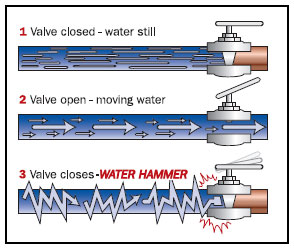Closing or opening valves quickly – or initiating pumps to stop – can cause pressure transients in pipelines known as surges or water hammer.

One "Water hammer" or " hydraulic hammer” in the pipe or tube is a pressure spike caused by a sudden change in flow rate.
Waterhammer can be created if:
- valves open or close fast.
- pumps stop or start suddenly.
- parts of the plumbing burst.
And velocity energy is converted into pressure energy. As the flow of water is restricted within a pipe, a shock wave will travel back and forth through the incompressible water in the pipe, deflecting everything in its path.
As liquids have very low compressibility, the resulting pressure energy can be very high. If the shock wave intensity is high, physical damage to the system may occur.
The peak pressure of water hammer in a pipeline caused by closing or opening a valve can be estimated as:
Δ p = 0.070 Δv l / Δ t (1)
Where
Δ p = increase in pressure – peak pressure (psi)
Δ v = change in flow velocity (ft/s)
Δ t = valve closing time (s)
l = length of upstream pipe (ft)
- 1 pe (pe) = 0.3048 m
- 1 pé/s = 0,3048 m/s
- 1 psi (lb/in 2 ) = 6894,8 Pa (N/m 2 )
Example – water hammer generated when closing a solenoid valve
The pressure peak (water hammer) in a water pipe of 100 feet where the speed of water flow is reduced by 6 sp/s for 0 pes/s when a solenoid valve closes on 0,1 s – can be estimated as:
Δ p = 0.070 ((6 pes/s) – (0 pes/s) ) (100 pes) / (0.1 s)
= 42 0 (psi)
With a closing time of 1 s (solenoid valve with damper) – peak pressure (water hammer) can be estimated as:
Δ p = 0.070 ((6 pe/s) – (0 pe/s) ) (100 pe) / (1 s)
= 42(psi)
To avoid water hammer damage piping systems.
- open and close valves slowly
- use soft starters to start/stop pumps
Source: https://www.engineeringtoolbox.com/water-hammer-d_966.html









